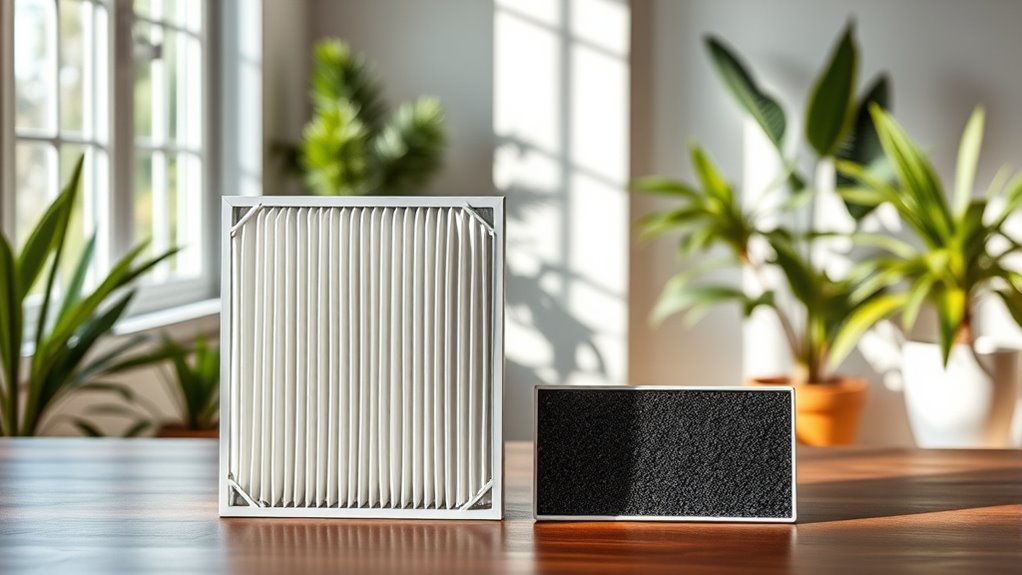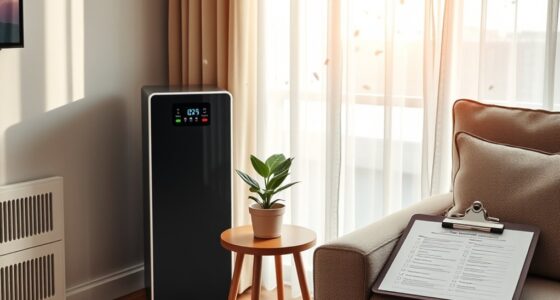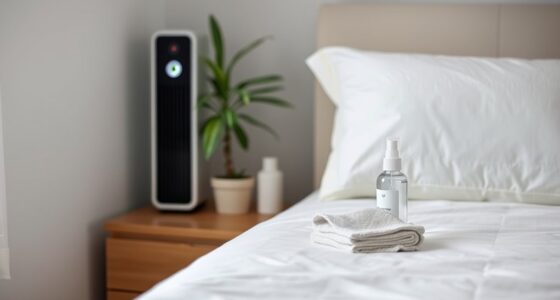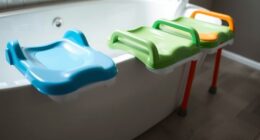HEPA filters are excellent at capturing tiny particles like dust, pollen, and allergens, creating a cleaner indoor environment. Activated carbon, on the other hand, absorbs odors and VOCs, neutralizing smells from pets, smoke, and cooking. While they serve different purposes, combining both filters offers extensive air purification. Understanding their strengths and limitations helps you make better choices for your wellness. Keep exploring to discover how to maximize your home’s air quality effectively.
Key Takeaways
- HEPA filters excel at capturing small particles like dust, pollen, and allergens, while activated carbon targets odors and chemical gases.
- Combining HEPA and activated carbon filters provides comprehensive indoor air purification, addressing both particulates and gaseous pollutants.
- HEPA filters do not absorb odors or VOCs; activated carbon is necessary for effective odor and chemical removal.
- Regular filter replacement is essential: HEPA filters last 6-12 months, activated carbon requires changing every 3-6 months for optimal performance.
- Understanding each filter’s limitations prevents over-reliance, ensuring better indoor air quality and overall wellness.
How HEPA Filters Capture Particles and Allergens
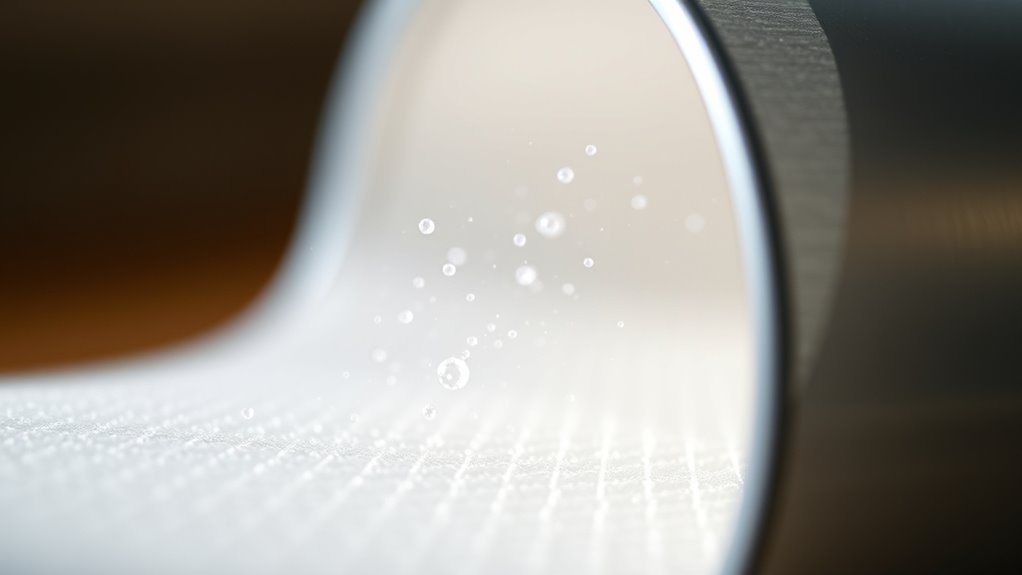
HEPA filters work by trapping tiny particles as air passes through them, making them highly effective at removing allergens and airborne contaminants. With HEPA filtration, you can expect to markedly reduce dust, pollen, pet dander, and mold spores from your indoor air. The dense fibers in HEPA filters create a web-like barrier that captures particles as small as 0.3 microns, ensuring thorough allergen removal. As air flows through the filter, these particles get trapped and can’t circulate back into your living space. This process helps improve indoor air quality, especially if you suffer from allergies or asthma. By using HEPA filtration regularly, you create a cleaner, healthier environment that minimizes exposure to airborne irritants and allergens.
The Science Behind Activated Carbon’s Absorption Power
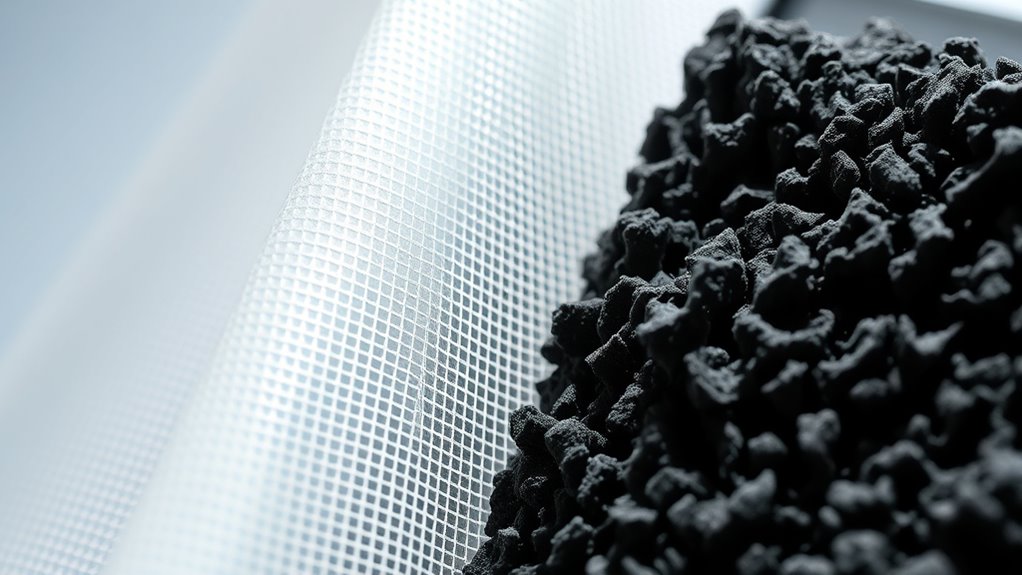
Activated carbon’s remarkable absorption power stems from its highly porous structure, which provides an immense surface area for trapping contaminants. This extensive pore structure allows adsorption mechanisms to work effectively, pulling in pollutants from the air or water. When contaminants pass through, they adhere to the surface via physical and chemical interactions, such as Van der Waals forces. The pore size and distribution are critical because they determine which molecules can be captured. Larger pores trap bigger particles, while smaller pores target gases and odors. Because of this, activated carbon excels at adsorbing a wide range of impurities. Its effectiveness depends on the material’s pore structure, making it a versatile and powerful filtration medium that captures pollutants on contact through surface interactions.
Common Misconceptions About Air Purification Technologies
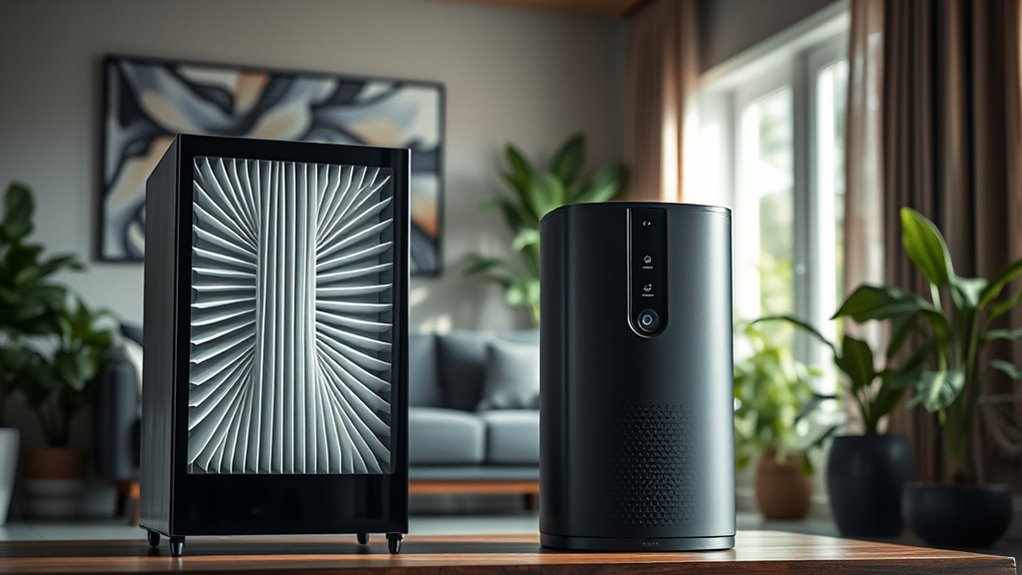
Many people believe that air purification technologies can instantly and completely eliminate all airborne pollutants, but this isn’t entirely true. This is a common air purifier myth, leading to unrealistic expectations. Not all filter material differences perform the same; some excel at removing dust, while others target allergens or gases. For example, HEPA filters trap particles but don’t absorb odors, whereas activated carbon excels at odor removal but isn’t as effective against fine particles. Knowing these differences helps you choose the right technology for your needs. Relying solely on one type of filter can give a false sense of security. Understanding the limitations of different air purifier myths ensures you don’t overestimate their capabilities and helps you make informed decisions for better home air quality.
Effectiveness Against Odors and Volatile Organic Compounds
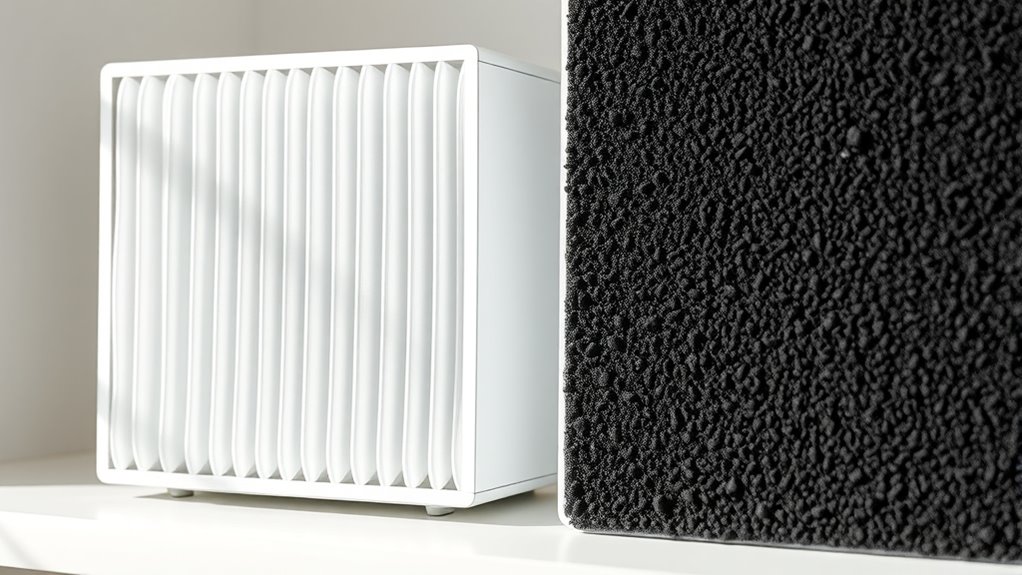
When it comes to odors and VOCs, activated carbon is known for its strong absorption capabilities, making it highly effective at removing stubborn smells. HEPA filters, on the other hand, primarily target particulates but can also reduce some odors with additional treatments. Consider how each system’s filtration efficiency, lifespan, and maintenance needs impact their overall performance in neutralizing airborne contaminants.
Odor Absorption Capabilities
Hepa filters excel at trapping odors and volatile organic compounds (VOCs) because their dense, fibrous structure captures particles as air passes through. While they effectively remove airborne viruses and allergens, their ability to absorb odors is limited. You’ll notice they excel at filtering particulate matter but don’t markedly neutralize smells or chemical odors. For odor absorption, activated carbon outperforms HEPA filters because its porous surface adsorbs gases and volatile compounds directly. If odor control is your priority, relying solely on HEPA might leave odors lingering. However, combining a HEPA filter with activated carbon can provide thorough air purification—trapping airborne viruses and allergens while effectively neutralizing unwanted smells. This hybrid approach maximizes your home’s air quality and overall wellness.
VOC Filtration Efficiency
While HEPA filters are excellent at capturing airborne particles, their ability to target volatile organic compounds (VOCs) and odors is limited. Activated carbon, on the other hand, excels at VOC filtration due to its porous surface. To maximize effectiveness:
- Air exchange rate: Higher air exchange speeds up odor removal but can shorten filter lifecycle.
- Filter saturation: Activated carbon filters can become saturated quickly, reducing VOC absorption.
- Proper placement: Positioning the filter in high-traffic areas improves VOC removal efficiency.
You’ll notice that activated carbon’s porous structure adsorbs VOCs and odors effectively, but it requires regular replacement to maintain performance. Balancing air exchange and filter lifecycle guarantees your space stays fresh and free of harmful VOCs.
Longevity and Maintenance
Activated carbon filters typically need replacement every three to six months to maintain their effectiveness against odors and VOCs. The air filter lifespan largely depends on usage, air quality, and the environment, so regular monitoring is essential. While the replacement costs for activated carbon filters are generally affordable, neglecting timely changes can compromise air quality and lead to increased odors or VOC buildup. Unlike HEPA filters, which may last longer but require more frequent cleaning or replacement if contaminated, activated carbon’s efficiency diminishes as the porous material becomes saturated. To guarantee maximum performance, plan for periodic replacements and check your filter’s condition regularly. Proper maintenance not only preserves the filter’s ability to neutralize odors but also extends its overall lifespan, saving you money in the long run.
Maintenance and Longevity: What to Expect From Each Filter Type
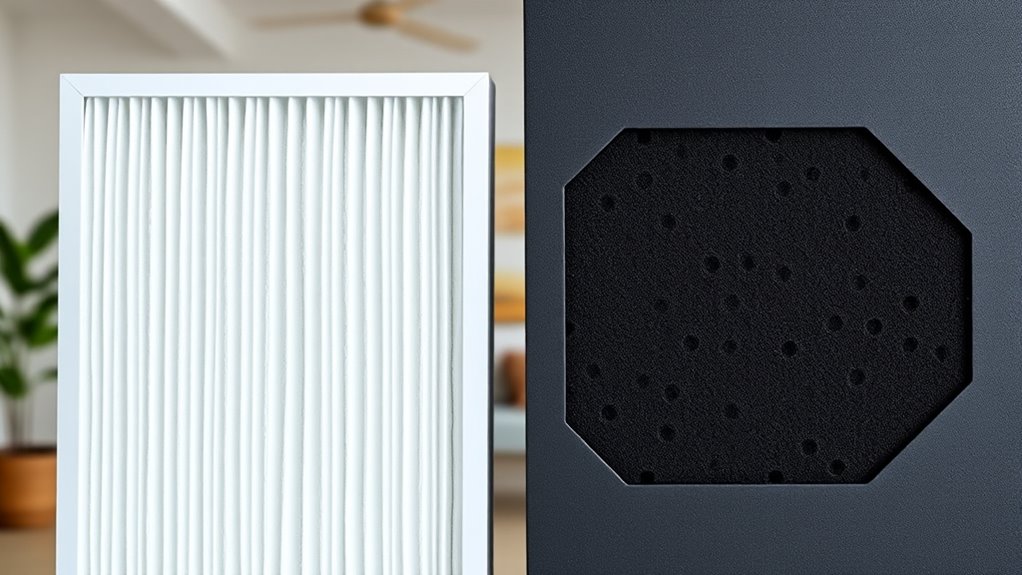
Maintaining these filters is essential to guarantee they perform effectively over time. Proper upkeep ensures your air stays clean and your system lasts longer. For both HEPA and activated carbon filters, you’ll need to follow specific cleaning procedures and schedule regular filter replacements.
Here are key points to keep in mind:
- Replace HEPA filters every 6-12 months, depending on usage and air quality.
- Clean activated carbon filters regularly if washable, or replace when saturation occurs.
- Always follow manufacturer instructions for filter replacement and cleaning procedures to maximize longevity.
Cost Considerations and Long-Term Investment
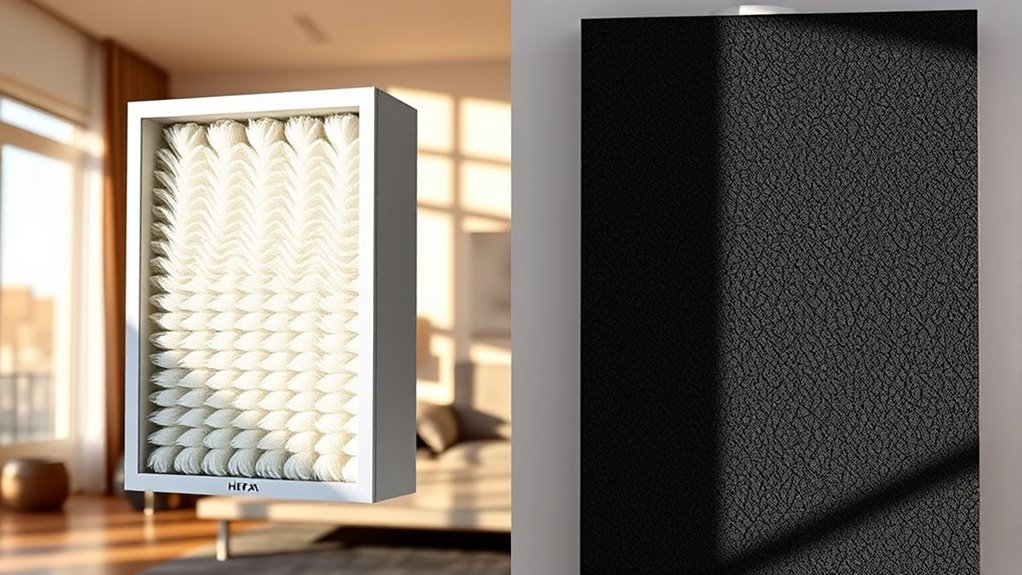
Choosing between HEPA and activated carbon filters involves considering not just their initial costs but also their long-term expenses. The cost comparison reveals that HEPA filters often have higher upfront prices but may last longer, reducing replacement frequency. Activated carbon filters generally cost less initially but require more frequent changes due to saturation with pollutants. This affects your overall investment benefits over time.
| Filter Type | Initial Cost | Replacement Frequency | Long-Term Cost | Maintenance Effort |
|---|---|---|---|---|
| HEPA | Higher | Less frequent | Potentially lower | Moderate |
| Activated Carbon | Lower | More frequent | Potentially higher | Easier |
Your choice impacts your budget and wellness investment.
Combining HEPA and Activated Carbon for Optimal Home Wellness
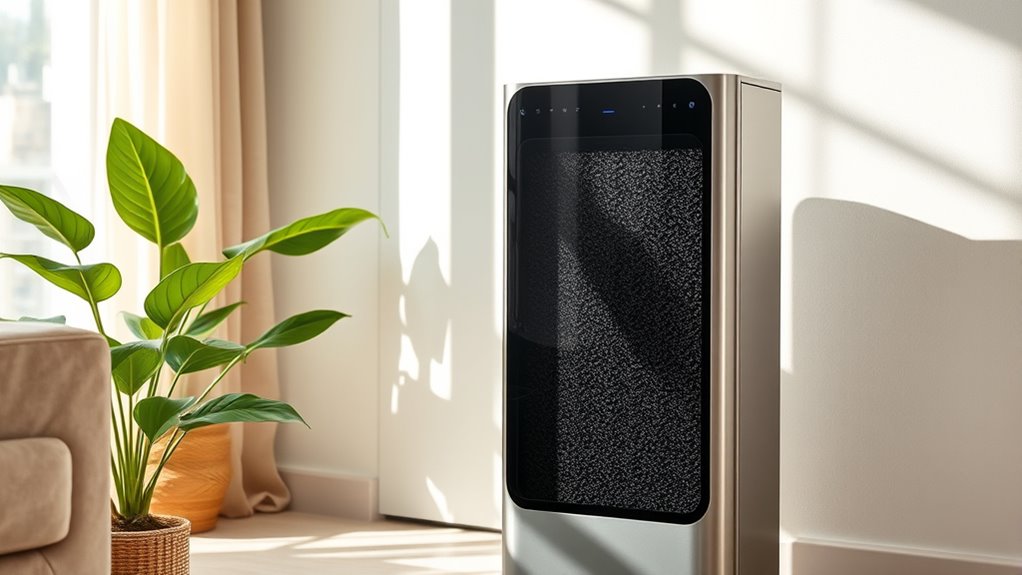
Have you considered combining HEPA and activated carbon filters to maximize your home’s air quality? This combo offers significant air quality improvements by capturing both airborne particles and odors or chemicals. To get the most benefits, keep these tips in mind:
- Use a HEPA filter for dust, pollen, and allergens.
- Add an activated carbon filter to absorb VOCs and odors.
- Regularly replace filters based on manufacturer guidelines for peak performance.
Frequently Asked Questions
Can HEPA Filters Remove Bacteria and Viruses Effectively?
Yes, HEPA filters can effectively eliminate airborne pathogens like bacteria and viruses, capturing particles as small as 0.3 microns. They help improve air quality and reduce health risks. However, their efficiency depends on proper maintenance and filter longevity; clogged filters lose effectiveness. Regularly replacing HEPA filters ensures continuous removal of airborne pathogens, keeping your indoor air safer and healthier.
Do Activated Carbon Filters Release Any Harmful Substances During Absorption?
Absolutely, activated carbon filters generally don’t release harmful substances during absorption. They’re designed to trap chemicals and odors safely, preventing chemical emissions. However, poor-quality filters or those that degrade over time might pose risks, so always choose high-quality, certified filters for maximum filter safety. Regularly replacing filters ensures they operate effectively without releasing unwanted substances, keeping your indoor environment clean, safe, and free from harmful chemical emissions.
How Do Humidity Levels Affect the Performance of HEPA and Carbon Filters?
Humidity levels can interfere with filter efficiency by causing moisture buildup, which reduces the effectiveness of HEPA and activated carbon filters. High humidity fosters mold growth and clogs filters faster, while low humidity can cause static buildup. To maintain ideal performance, keep humidity at a moderate level, around 40-60%. This prevents humidity interference and guarantees your filters work effectively, improving indoor air quality and comfort.
Are There Specific Allergens That HEPA Filters Cannot Capture?
You should know that HEPA filters have allergen limitations; they can’t capture certain allergens like gases, odors, or very tiny particles like some viruses. These are often considered filter blind spots, meaning some airborne contaminants slip through. If you’re worried about these allergens, consider adding activated carbon filters to target odors and chemicals, complementing your HEPA’s ability to trap larger particles like pollen, dust, and pet dander.
What Are the Environmental Impacts of Disposing Used Activated Carbon Filters?
You might think disposing of activated carbon filters is harmless, but it actually impacts the environment more than you realize. When you toss them out as regular waste, filter disposal can contribute to environmental pollution because the carbon can release absorbed toxins. Recycling options are limited, so it’s better to explore eco-friendly disposal methods or reuse options to reduce your carbon footprint and protect the environment.
Conclusion
Choosing between HEPA and activated carbon isn’t easy, but understanding their strengths helps you make the best decision for your home. Why settle for just one when you can combine them for maximum health benefits? By investing in the right filters, you’re not just improving air quality—you’re creating a safer, more comfortable space for you and your loved ones. Isn’t your home worth the best protection possible?
